These Sourdough Discard Rosemary Salt Bagels are delicious, packed with fresh rosemary and topped with flaky sea salt. They're great with eggs for breakfast, to make a lunch sandwich (BLTs, anyone?), or even served with your favorite cream cheese.

Jump to:
Why You'll Love This Recipe
- The flavor combination of the rosemary and the flaky sea salt is so delicious! These rosemary bagels smell incredible coming out of the oven. You might also love this Rosemary Sourdough Focaccia!
- Salt bagels are great for breakfast, lunch, or a snack.
- Homemade bagels freeze well, so you can enjoy some now and freeze the rest for later! And if you love these, try my classic Sourdough Discard Bagels.
- This recipe uses sourdough discard, but can easily be modified to use active sourdough starter and no commercial yeast if you prefer.
Ingredients
There are only a few key ingredients you'll need to make these salted bagels.

- Sourdough discard: The discard should be unfed and at room temperature for this recipe. This recipe is designed for a sourdough starter with a 1:1 ratio (when you feed your starter, it's with 1 part flour and 1 part water). If your starter uses a different ratio, you may need to adjust some of the ingredients in this recipe.
- Learn more here about making a homemade sourdough starter.
- Fresh rosemary: I highly recommend using fresh rather than dried rosemary. A coarse chop is fine!
- Flaky sea salt: I like to use Maldon Sea Salt to finish the bagels.
Substitutions & Variations
This is a very adaptable recipe and below are a few easy substitutions and variations you can try.
- Use active sourdough starter: To make these bagels with active sourdough starter, omit the yeast and replace the sourdough discard with active starter (200g). You'll also need to increase the rise times for the recipe.
- Add roasted garlic: Roast 1 head of garlic in the oven. Once cooled, remove the garlic from the skins and discard the skins. Coarsely chop the garlic and add it to the dough when you're adding the sourdough discard. Continue with the recipe as written.
- You might also love these Sourdough Discard Garlic Rolls!
- Omit the rosemary: If you want a plain salted bagel with no herbs, omit the rosemary.
- Egg wash alternative: If you're not baking with eggs, you can omit the egg wash and brush the bagels with melted butter or even water before sprinkling with sea salt. The point is to hold the sea salt on the bagel. Either an egg wash or butter will work best (water will not be as secure). Continue to bake as directed.
- If you're looking for a few other bagel options, try these blueberry bagels and these cinnamon raisin bagels!
I have not tested this recipe with other variations, but if you do, let us know how it turns out in the comments! I always love to hear how you're adapting these recipes and use those as ideas for future recipes as well!
How to Make Sourdough Discard Rosemary Salt Bagels
These rosemary bagels come together in a few easy steps.
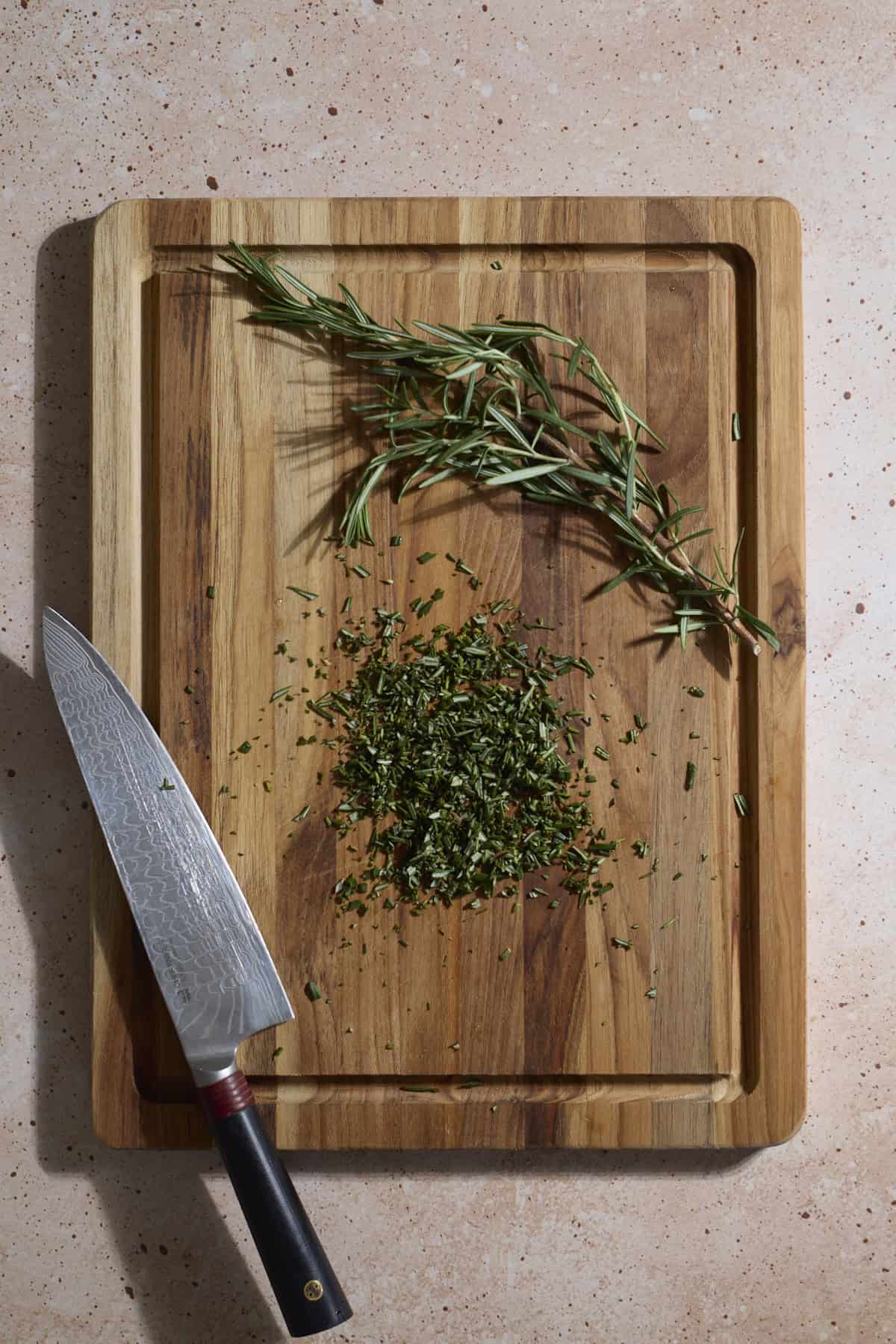
- Step 1: Coarsely chop the rosemary and set aside.

- Step 2: Combine all ingredients for the dough and mix until a shaggy dough forms.

- Step 3: Knead until smooth and soft. Transfer to an oiled bowl, cover and let rise for 60-90 minutes.
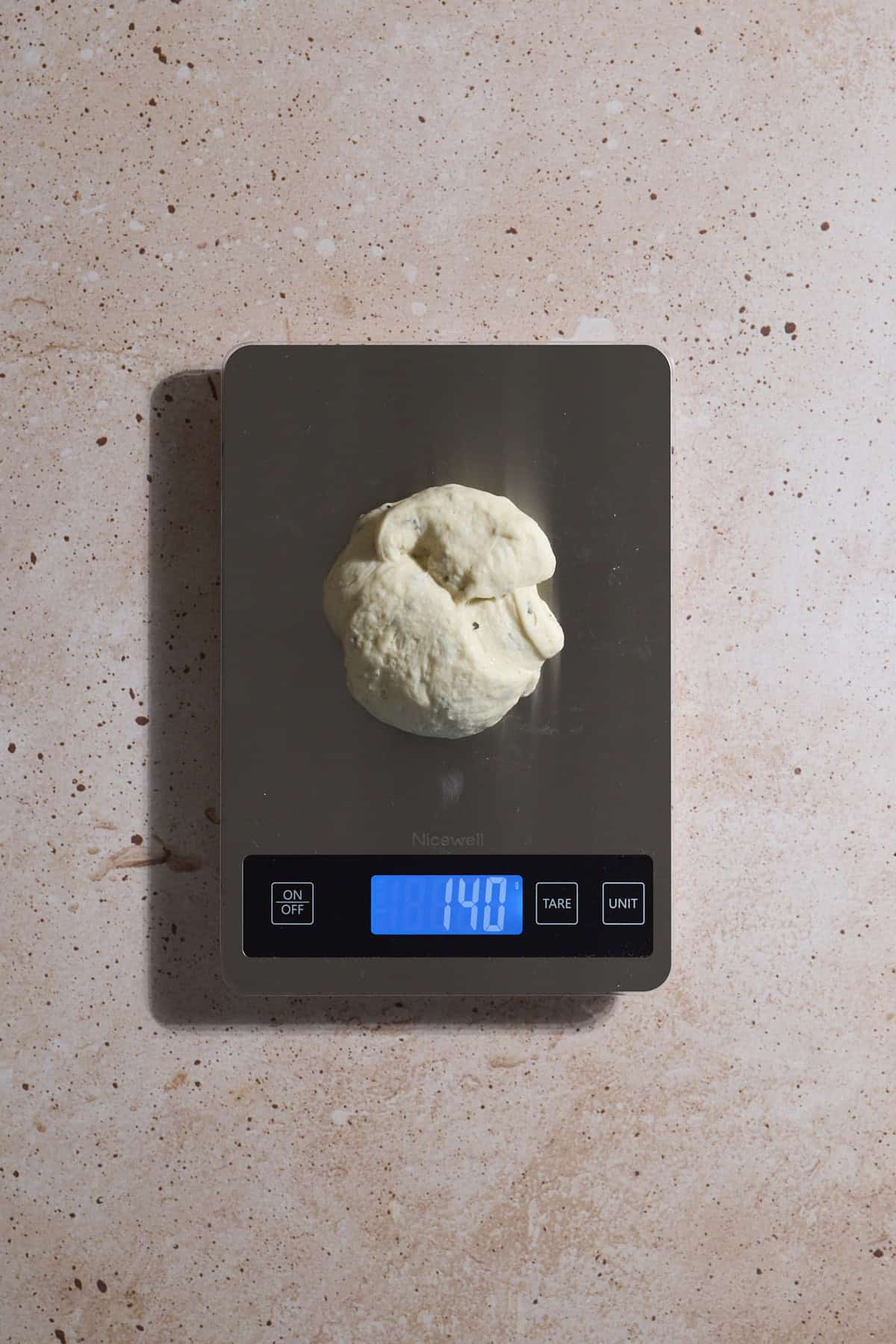
- Step 4: Divide the dough into 8-10 equal--size pieces. I recommend using a kitchen scale.

- Step 5: Roll each piece into a ball in the palm of your hand.

- Step 6: Use your thumbs to press a hole through the center. Make this hole bigger than you think it should be! Cover the shaped bagels and let rest while you prepare the next step.

- Step 7: Boil the bagels with baking soda for 15-30 seconds on each side. Shake off any excess water and transfer to your baking sheet.
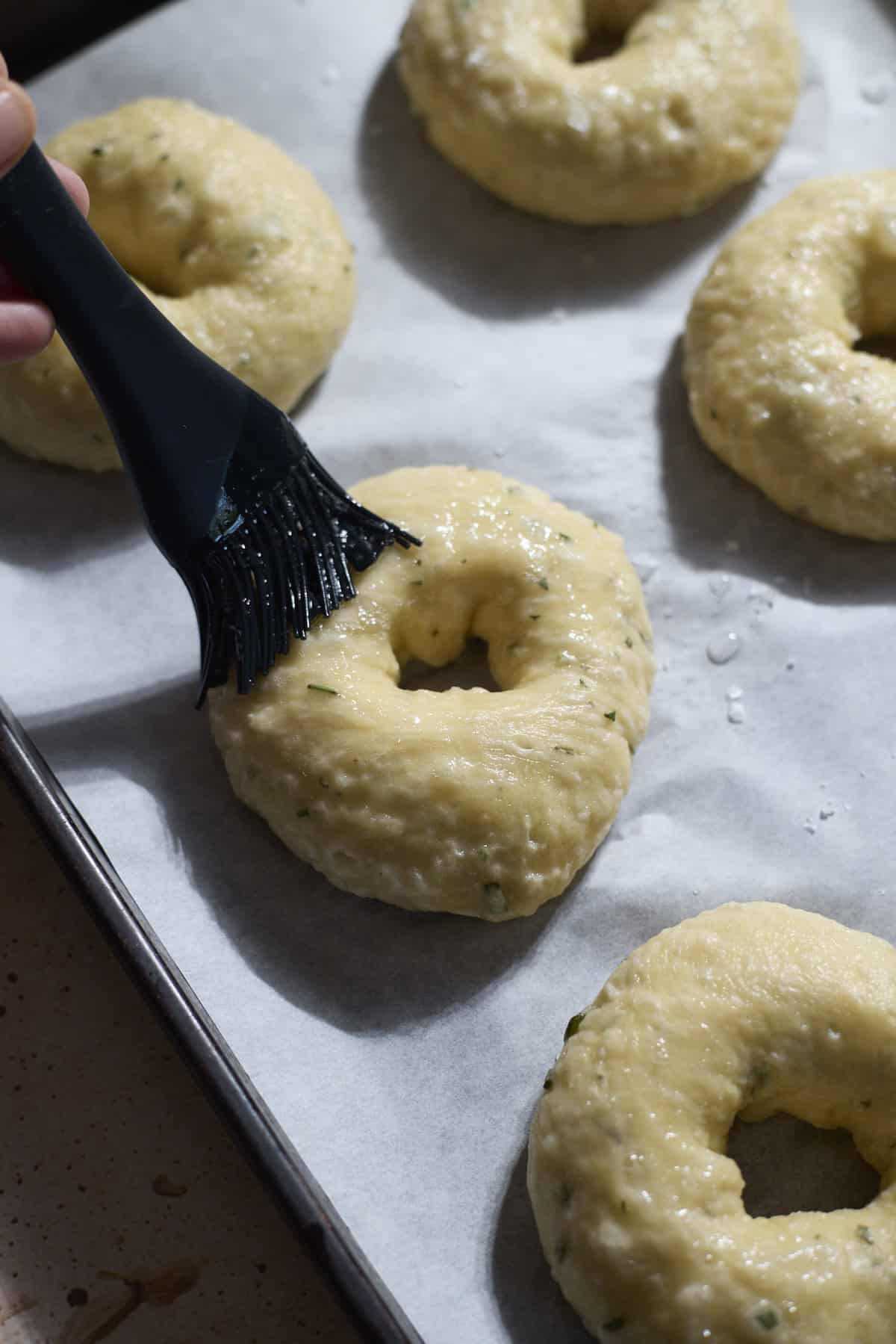
- Step 8: Brush with egg wash, sprinkle with flaky sea salt, and bake until golden!
Expert Baking Tips
- Knead the dough long enough. Knead until your dough is completely soft and smooth before the first rise.
- Be patient with the rise! Rise times will vary depending on the temperature of your room. In a warmer room, the dough will rise quicker. In a cooler room, the dough will rise slower. If needed, let the dough rise longer!
- Be careful of letting the dough over-rise (overproof)! If you let the dough more than double in size, your bagels will be very puffy and may even look more like rolls. They'll still be delicious, but will look less like a bagel.
- Make the bagel hole larger than you think it should be. The dough will rise quite a bit while boiling and baking, and it's easy for the center hole of the bagel to close up.
- Pass the float test! When you put your bagels into the boiling water, they should float. If they don't, cover and let rest for 10 minutes before trying again.
What is "Passing the Float Test"?
When you add your bagels to the boiling water, they should float. This is called "passing the float test." I recommend boiling one bagel first, as a tester, so you can adjust as needed.
When you boil your bagels, you might see:
- Your bagels float immediately: You've passed the float test! Continue boiling and baking as directed.
- Your bagels sink to the bottom, but float after a few seconds: This also counts as passing the float test! Continue boiling and baking as directed.
- Your bagels do not float: If your bagels don't float, this indicates that the dough has not risen enough. Cover the unboiled bagels with a clean kitchen towel or plastic wrap and let rest for another 10 minutes, then try again.
- You can still bake the bagel that you already boiled! It will still be good, but may be a bit more dense than the others.
Storage
Room Temperature Storage: Homemade bagels are best fresh, of course! Once cooled, store the bagels in a paper bag at room temperature for 1-2 days. Reheat the bagels in the microwave for about 30 seconds to make them warm and soft again.
- Be prepared that the salt will wick moisture from the air and make the bagels slightly "damp." I highly recommend either eating them right away, or freezing the bagels if you want to eat them later!
Freezer Storage: Salted bagels freeze very well. Once fully cooled, you can freeze the bagels in a freezer-safe plastic bag or container for up to 3 months. Reheat frozen bagels in the microwave for about 60 seconds until warm and soft again.

Recipe FAQs
No! You can make homemade bagels by mixing the dough in a large bowl with a wooden spoon, then kneading by hand.
Fresh rosemary is going to give you the best flavor for these bagels, and I highly recommend it! In a pinch, you could use dried rosemary. For this recipe, you would use 2 teaspoons dried rosemary in place of the 2 Tablespoons of fresh rosemary.
If your bagels aren't floating during boiling, they are not "passing the float test." That means that the dough hasn't risen long enough. Cover the unboiled bagels with a clean kitchen towel or plastic wrap and let rest for another 10 minutes, then try again.
Yes! If you want to add garlic, roast 1 head of garlic in the oven. Once cooled, remove the garlic from the skins and discard the skins. Coarsely chop the garlic and add it to the dough when you're adding the sourdough discard. Continue with the recipe as written.
I highly recommend using a flaky sea salt such as Maldon Sea Salt or a coarse pretzel salt. You don't want to use regular table salt or kosher salt that is finer, as that will just melt into the bagels.
More Sourdough Discard Bagel Recipes
If you tried these Sourdough Discard Rosemary Salt Bagels or any other recipe on my website, please leave a star rating and let me know how it went in the comments below. I'd love to hear from you! Happy Baking!

Sourdough Discard Rosemary Salt Bagels
Ingredients
For the Dough
- 4 cups bread flour
- 3 Tablespoons granulated sugar divided
- 2 Tablespoons fresh rosemary chopped
- 1 teaspoon instant yeast
- 1 teaspoon kosher salt
- 200 grams (about ¾ cup) sourdough discard unfed, at room temperature
- 1 ¼ cups warm water
For Topping
- 1 egg white
- 1 Tablespoon water
- flaky sea salt
Instructions
- Combine flour, 1 Tablespoon granulated sugar, chopped rosemary, yeast, and salt in the bowl of a stand mixer fitted with the dough hook attachment*. Mix to combine.Note: The remaining 2 Tablespoons of granulated sugar will be used when boiling the bagels.
- Add the sourdough discard. With the mixer on low speed, slowly add the warm water and mix until combined. Increase speed to medium and mix until a shaggy dough forms. Transfer the dough to a clean work surface and knead by hand for 4-5 minutes until a smooth ball forms**. This will be a fairly sturdy dough and should not be sticky. You may need to add more water or more flour (1 Tablespoon at a time), depending on your sourdough discard, to reach the right dough consistency.
- Grease a large bowl, transfer the dough to the bowl, and cover with plastic wrap or a clean kitchen towel. Let the dough rise for 60-90 minutes, or until doubled in size.
- Turn the dough out onto a clean work surface and divide into 8-10 equal pieces. 8 pieces will give you 8 large bagels; 10 pieces will give you 10 smaller bagels. When making 8 bagels, the dough weighs about 139g for each portion. Roll each portion of dough into a smooth ball, using one palm for friction. Use your thumbs to press through the center of each ball, stretching the hole to form your bagel. Make this hole larger than you think it should be (it will get smaller during the boiling and baking process). Cover the bagels with a clean kitchen towel and let rest for 20 minutes while you prepare the next step.
- Preheat oven to 425°F. Prepare 2 baking sheets lined with parchment paper and set aside. Bring a pot with 2 quarts of water and 2 Tablespoons granulated sugar to a boil.
- Place your bagels in the boiling water for 15-30 seconds on each side. The bagels should float (if not, see notes below). You can likely fit 2-3 bagels in the pot at a time, just make sure there is enough room for them to float openly. Remove from the boiling water using a slotted spoon or spatula and transfer to the prepared baking sheets. If needed, you can reshape the bagels a little after they've cooled.
- Whisk together the egg white and 1 Tablespoon water to create the egg wash. Lightly brush the bagels with egg wash, then sprinkle with the flaky sea salt.
- Bake for 18-22 minutes or until golden brown, flipping and rotating the baking sheets halfway through. Let cool fully, then slice and serve.




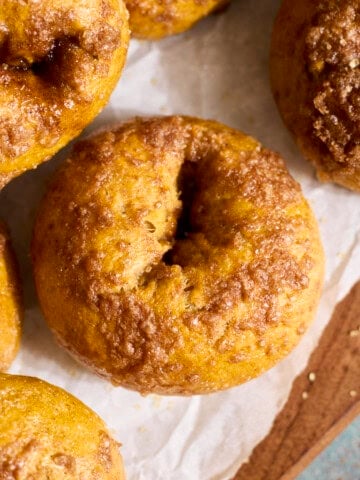
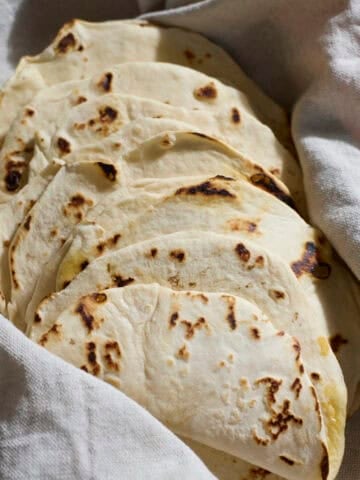


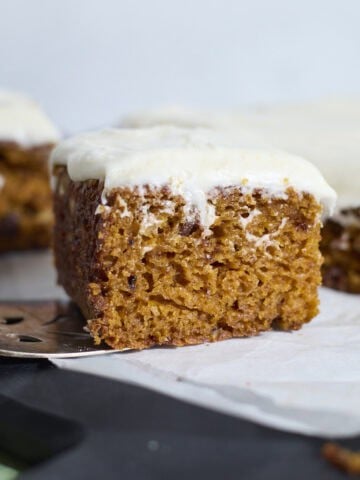
Kim says
It would be super appreciated if you would also have the metric amounts. Since so many normal sourdough recipes use metric and honestly its way less mess if i can just weigh everything instead of using 6 different measuring cups and spoons.
Jessica Vogl says
Hi there! Just a heads up that this is not a sourdough recipe (although I might convert it into one!). And yes, I'm working on adding metric measurements to all of my recipes. This is an older one, so it just hasn't been updated yet, but thank you for flagging!
Danielle Netherton says
Oh please do convert this to a sourdough recipe!!
Steph says
First time making bagels and this recipe was so easy to follow! I enjoyed the process very much. They came out absolutely delicious and zero complaints from my family. Thank you!